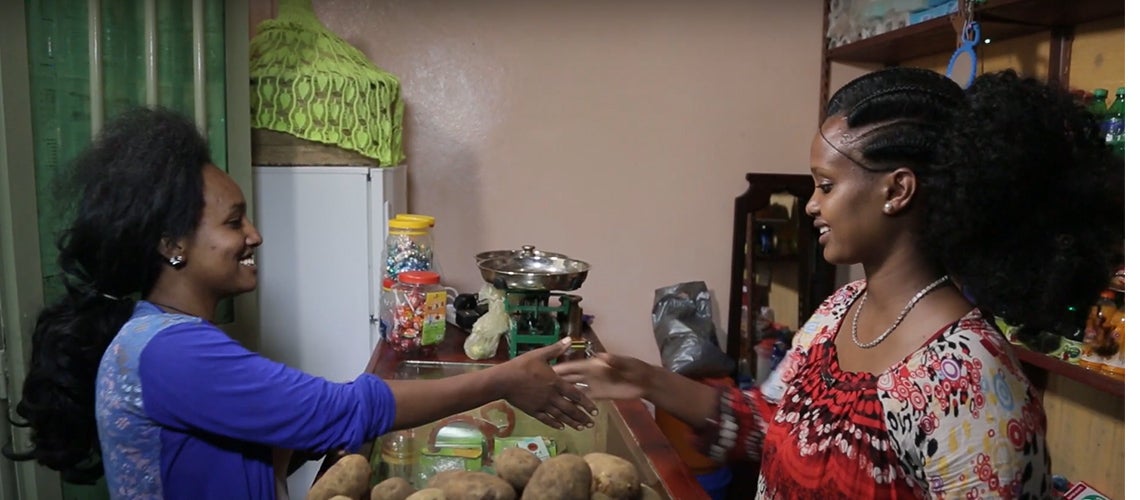 Tirhas (right) is a refugee and shop keeper in Ethiopia. She is shaking hands with a customer.
Tirhas (right) is a refugee and shop keeper in Ethiopia. She is shaking hands with a customer.
Long-drawn-out political strife, instability, conflict and climate change have all contributed to 4 million people being internally displaced, and 9 million people moving across national borders in the Horn of Africa. This region is feeling the spill-over effects of a protracted refugee crisis in South Sudan, Somalia and the Democratic Republic of Congo. According to UNHCR, the host countries with the largest numbers of refugees are Uganda with 1.38 million, and Ethiopia with 735,204, and Sudan with 1.1 million.
Many of the refugees from South Sudan, Sudan, and Eritrea have gone to Ethiopia, where they are living in camps. To support the refugee-hosting communities in Ethiopia, the World Bank financed the Ethiopia Development Response to Displacement Impacts Project (DRDIP). The project, approved in 2016, focuses on providing social services and economic opportunities to communities in the states of Somali, Gambella, Tigray, Afar and Benishangul-Gumuz—where large number of refugees are putting a strain on health and educational services.
Improving education and health in host communities by increasing capacity and improving accessibility—particularly for women and girls—is a priority for this project. Given the significant gender disparities in the host communities, the project focuses on women, women-led households, and youth—groups that are disproportionately affected by the impact that forced displacement has on access to health and education.
Before the project was rolled out, the implementation team took a snapshot assessment of how the communities were faring before the project (known as the comparison group). Doing this enabled the team to assess the project impact and decide whether the project design needed adjustment to be more effective. The team noted that the average size of households, age, and schooling attainment of household heads, in addition to landholdings, in both treatment and comparison groups were similar: at least 60 percent of household heads had never participated in any informal or formal schooling and households whose heads had a higher level of education tended to have smaller households.
The assessment also revealed that a quarter of school-age children had never attended school and that level of schooling across all grades except for the fifth and sixth grades were similar between treatment and comparison households. There was also a noticeable decline in the proportion of children that were attending higher grades in both treatment and comparison households. Regarding the health facility assessment, it was noted that the distance and time it took to reach the nearest health care facility was similar across both groups and that 87 percent of the comparison communities had a small healthcare facility –or health post-- relative to 77 percent of the treatment communities.
As part of the effort to ensure that the Ethiopia DRDIP project is on track and making a difference, the project team conducted a mid-term review on 86 schools and 31 health centers, and the results are encouraging. Field observations show that formally dilapidated schools (sheds with thatched roofs that expose students to wind and dust), have been upgraded to regular schools with large and well-ventilated classrooms with proper furniture. All schools have been assigned headmasters and regular teachers and as a result, all upgraded schools have seen an uptick in enrolment and attendance, as well as showed tremendous improvements in the learning environment.
Thanks to more conveniently-located health facilities, more women are receiving prenatal and postnatal care and are going to these facilities for delivery. Also, more children can get to the health facilities to receive immunization. Dilapidated structures have been upgraded, and doctors and health workers are more effectively assigned and supplied with equipment, power supply, and refrigeration—critical for storage of vaccines.
The World Bank task team, in coordination with the project implementation unit that includes Ethiopian government officials, is now starting the endline evaluation to assess the impact of the first round of education and health subprojects that have been running for over a year. The impact evaluation results should be available in May 2020. We look forward to sharing these results with you then.
This work is part of the program “Building the Evidence on Protracted Forced Displacement: A Multi-Stakeholder Partnership" funded by UK aid from the United Kingdom's Department for International Development (DFID).


Join the Conversation